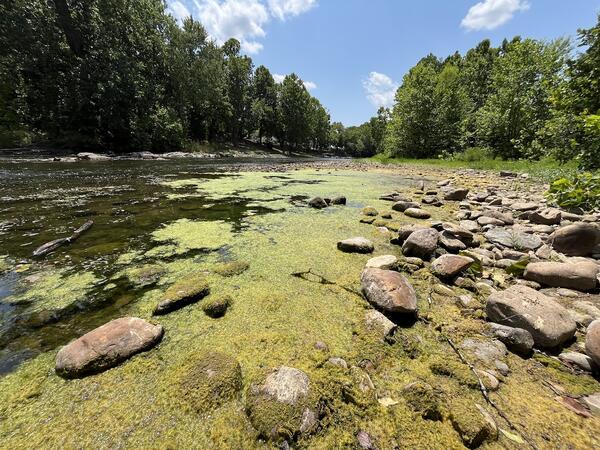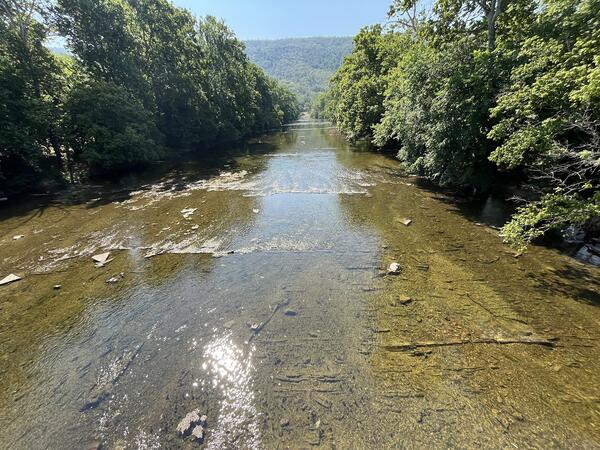Algae Mat from a Harmful Algal Bloom
Detailed Description
Algae growing over the rocky streambank of the south fork of the Shenandoah River near Lynnwood, Virginia.
This photo was taken as a part of the Shenandoah River HABs Project.
Data for this monitoring site can be found at USGS Water Data for the Nation.
Sources/Usage
Public Domain.
Related
Investigation of Drivers of Harmful Algal Blooms on the Shenandoah River, Virginia
The U.S. Geological Survey (USGS), in cooperation with the Viriginia Department of Environmental Quality (DEQ) and collaboration with the Interstate Commission on the Potomac River Basin (ICPRB) is monitoring harmful algal blooms (HABs) on the two forks of the Shenandoah River in Virginia. Continuous and discrete water-quality and hydrology data is conducted to understand the drivers, persistence...
Harmful Algal Blooms Investigations at the Virginia and West Virginia Water Science Center
Excessive accumulations of algae that impair waterbodies, called harmful algal blooms (HABs), can have detrimental effects on aquatic ecosystems, reduce the quality of water resources, and can pose significant risks to human and animal health. The Virginia and West Virginia Water Science Center works with state, regional, and local partners to evaluate the drivers and distribution of harmful algal...
Shenandoah HABs
Shenandoah HABs
Filter Total Items: 29

Collecting groundwater samples near the Shenandoah River

Shallow Groundwater Sample from the Banks of the Shenandoah River

Monitoring equipment along the North Fork Shenandoah River

North Fork Shenandoah River during a Harmful Algal Bloom Event

Harmful Algal Bloom in the Shenandoah River North Fork

Water chemistry monitoring equipment covered in algae

Deploying oxygen exchange sensors in the North Fork Shenandoah River

Monitoring station on the NF Shenandoah River near Strausburg.

North Fork Shenandoah River during a Harmful Algal Bloom Event
Related
Investigation of Drivers of Harmful Algal Blooms on the Shenandoah River, Virginia
The U.S. Geological Survey (USGS), in cooperation with the Viriginia Department of Environmental Quality (DEQ) and collaboration with the Interstate Commission on the Potomac River Basin (ICPRB) is monitoring harmful algal blooms (HABs) on the two forks of the Shenandoah River in Virginia. Continuous and discrete water-quality and hydrology data is conducted to understand the drivers, persistence...
Harmful Algal Blooms Investigations at the Virginia and West Virginia Water Science Center
Excessive accumulations of algae that impair waterbodies, called harmful algal blooms (HABs), can have detrimental effects on aquatic ecosystems, reduce the quality of water resources, and can pose significant risks to human and animal health. The Virginia and West Virginia Water Science Center works with state, regional, and local partners to evaluate the drivers and distribution of harmful algal...
Shenandoah HABs
Shenandoah HABs
Filter Total Items: 29

Collecting groundwater samples near the Shenandoah River

Shallow Groundwater Sample from the Banks of the Shenandoah River

Monitoring equipment along the North Fork Shenandoah River

North Fork Shenandoah River during a Harmful Algal Bloom Event

Harmful Algal Bloom in the Shenandoah River North Fork

Water chemistry monitoring equipment covered in algae

Deploying oxygen exchange sensors in the North Fork Shenandoah River

Monitoring station on the NF Shenandoah River near Strausburg.

North Fork Shenandoah River during a Harmful Algal Bloom Event
















